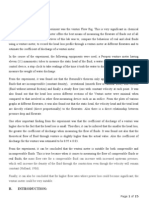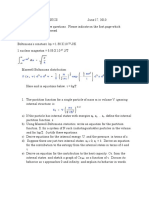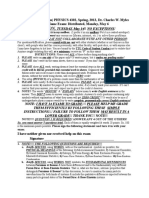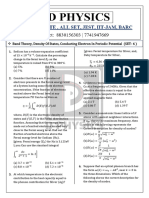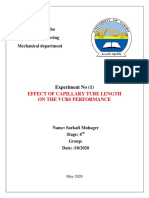Tut 3
Uploaded by
Akriti SinghTut 3
Uploaded by
Akriti SinghPYL558: Statistical Mechanics
Tutorial Sheet-3
1. For an ideal gas, calculate hv n i, hv 2 vx2 i, and hvx2 vy2 vz2 i.
2. Obtain the Maxwell-Boltzman, Bose-Einstein and Fermi-Dirac distribution functions by a
calculation in the microcanonical ensemble.
3. One kilo mole of hydrogen gas is at 105 K. If these atoms exist in the ground, first and second
excited state, calculate the number of atoms in the first excited state.
4. Suppose I have 10 particles in a box. What is the least amount of energy required to excite
a particle from its ground state configuration if the particles are (i) bosons, (ii) fermions and
(iii) electrons?
5. Count the number of standing waves/normal modes in a cubic cavity of length L on each side
(a) in the interval p and p + dp = g(p)dp,
(b) in the interval E and E + dE = g(E)dE,
(c) in the frequency range ν and ν + dν = g(ν)dν,
(d) in the wavelength range λ and λ + dλ = g(λ)dλ.
6. (a) It is always more convenient to use classical statistics. Show that in the high temperature,
low density limit, the two quantum statistics become identical to the classical statistics.
Obtain the condition for the validity of classical statistics.
(b) Can classical statistics be applied to a system of (i) 1023 molecules of hydrogen gas
occupying a volume of 20 litres at N T P ? (ii) electrons in a metal at 300 K, the electronic
density being 1029 /m3 ?
7. For an ideal Bose gas, obtain hvihv −1 i, where v is the velocity of bosons, as a function of T
and z = eβµ . Study the limiting case z → 0.
8. Show that an ideal Bose gas in two dimension does not exhibit Bose-Einstein condensation
unless T = 0.
9. Consider a radiation cavity of volume V at temperature T filled with a gas of photons, the
energy of a photon (corresponding to a frequency ω of the radiation mode) being ~ω. Using
the fact that photons are a gas of non-interacting bosons,
(a) obtain the Planck’s law in the form U(ν)dν = , where U(ν)dν is the energy content
in the frequency range ν and ν + dν.
(b) Further, verify Stefan’s law and Wien’s law for the radiation cavity.
(c) Obtain the expression for Radiation Pressure.
10. Generalize results (a) and (c) in the above problem for a d-dimensional radiation cavity.
11. Rederive the expressions for the Einstein and Debye specific heats using Bose-Einstein distri-
bution function.
12. Terms to be understood clearly in context of ideal Fermi systems :
(a) Free electron gas
(b) Fermi energy
(c) Fermi distribution at absolute zero and finite temperatures
(d) Degenerate Fermi gas
(e) Fermi sphere, momentum and velocity
13. The chemical potential at absolute zero of a free electron gas is called the Fermi energy.
Obtain an analytic expression for the Fermi energy. Also find the average energy of the
electron gas in terms of Fermi energy. Using these expressions calculate the Fermi energy for
protons in a heavy nucleus such as H80200 . The nuclear radius is given to be 8.7 × 10−15 m.
14. Show that if average occupancy of a state of energy EF + ∆E is f1 at any temperature, then
the average occupancy of a state of energy EF − ∆E is f2 = 1 − f1 . This is the reason for the
symmetry of the distribution of electron energies in a metal about EF at finite temperatures.
15. The small contribution to the electronic specific heat is related to the fact that electrons are
fermions. Show that this contribution is proportional to T .
You might also like
- Sols Mcquarry Statistical Mechanics PDFMNo ratings yetSols Mcquarry Statistical Mechanics PDFM20 pages
- All Master File Problem Set Statistical Mechanics June 2010 To Current 05 2014 PDFNo ratings yetAll Master File Problem Set Statistical Mechanics June 2010 To Current 05 2014 PDF15 pages
- All Master File Problem Set Statistical Mechanics June 2010 Thru Jan 2017 DMNo ratings yetAll Master File Problem Set Statistical Mechanics June 2010 Thru Jan 2017 DM26 pages
- Home Assignment 5 PHY 306/604 Statistical MechanicsNo ratings yetHome Assignment 5 PHY 306/604 Statistical Mechanics3 pages
- Pointon - An Introduction To Statistical Physics For Students75% (4)Pointon - An Introduction To Statistical Physics For Students210 pages
- SUMSEM2-2018-19 ECE1006 ETH VL2018199000757 Reference Material I 02-Jun-2019 Statistical Mechanics Bose Einstein and Fermi Dirac DistributionsNo ratings yetSUMSEM2-2018-19 ECE1006 ETH VL2018199000757 Reference Material I 02-Jun-2019 Statistical Mechanics Bose Einstein and Fermi Dirac Distributions18 pages
- 2.57 Nano-to-Macro Transport Processes Fall 2004: V L KK VKK N VNo ratings yet2.57 Nano-to-Macro Transport Processes Fall 2004: V L KK VKK N V7 pages
- Chapter 9 Problem Solutions: Inha University100% (3)Chapter 9 Problem Solutions: Inha University15 pages
- You May Not Start To Read The Questions Printed On The Subsequent Pages of This Question Paper Until Instructed That You May Do So by The InvigilatorNo ratings yetYou May Not Start To Read The Questions Printed On The Subsequent Pages of This Question Paper Until Instructed That You May Do So by The Invigilator6 pages
- Solution To Statistical Physics Exam: 29th June 2015No ratings yetSolution To Statistical Physics Exam: 29th June 201513 pages
- Quantum and Relativistic Corrections To Maxwell-Boltzmann Ideal Gaz ModelNo ratings yetQuantum and Relativistic Corrections To Maxwell-Boltzmann Ideal Gaz Model18 pages
- Fermi and Bose Gases: Anders Malthe-SørenssenNo ratings yetFermi and Bose Gases: Anders Malthe-Sørenssen17 pages
- PHYS393: Statistical and Low Temperature Physics Tutorial 3No ratings yetPHYS393: Statistical and Low Temperature Physics Tutorial 32 pages
- Band Theory,Density,Conducting Electron In Periodic Potential SET- 06No ratings yetBand Theory,Density,Conducting Electron In Periodic Potential SET- 064 pages
- CGPDTM 2023 - Mains Physics - Mock-2 - Heat & ThermodynamicsNo ratings yetCGPDTM 2023 - Mains Physics - Mock-2 - Heat & Thermodynamics5 pages
- Statistical Mechanics: by Dr. Amit Kumar ChawlaNo ratings yetStatistical Mechanics: by Dr. Amit Kumar Chawla50 pages
- 2017 SM LectureNotes 4 FreeElectronTheory PDFNo ratings yet2017 SM LectureNotes 4 FreeElectronTheory PDF11 pages
- Part II Statistical Mechanics, Lent 2005No ratings yetPart II Statistical Mechanics, Lent 200553 pages
- Chapter 17: Chemical Thermodynamics: 17.1 When Is A Process Spontaneous?No ratings yetChapter 17: Chemical Thermodynamics: 17.1 When Is A Process Spontaneous?4 pages
- Test 1 Declaretion Muhammad Shahmizan Bin SapuanNo ratings yetTest 1 Declaretion Muhammad Shahmizan Bin Sapuan3 pages
- University of Zakho College of Engineering Mechanical DepartmentNo ratings yetUniversity of Zakho College of Engineering Mechanical Department14 pages
- Fluid Mechanics: Engr. Cheryll C. MalibiranNo ratings yetFluid Mechanics: Engr. Cheryll C. Malibiran29 pages
- Thermodynamic & Transport Properties of Fluids (Rogers) 5eNo ratings yetThermodynamic & Transport Properties of Fluids (Rogers) 5e13 pages
- 09 Science Matter in Our Surrounding Test 020% (2)09 Science Matter in Our Surrounding Test 021 page
- 3.3 - Pressure Measurement (Pressure Head and Manometers) PDFNo ratings yet3.3 - Pressure Measurement (Pressure Head and Manometers) PDF15 pages


